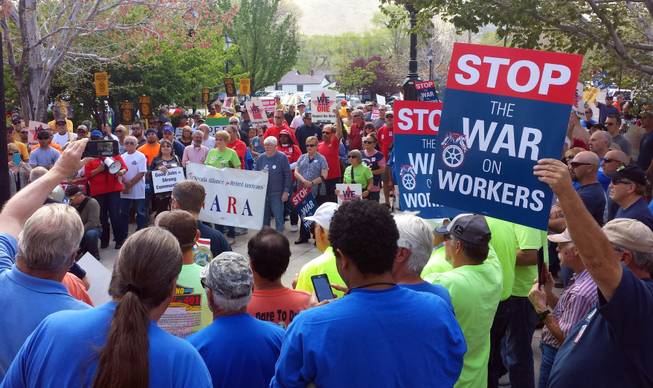
AP Photo / Michelle Rindels
Workers rally at a union protest Thursday, April 23, 2015, in Carson City, Nev. The workers are opposing Republican-sponsored bills in the Nevada Legislature that would alter public employee pensions and restrict collective bargaining.
Monday, May 18, 2015 | 2 a.m.
In the view of many, Nevada’s pension system for public employees is in relatively good health, with a sound plan to pay off its $12.5 billion unfunded liability while still maintaining the benefits it currently provides.
But to others, that unfunded liability is a troubling sign of a system in danger that could see its debt balloon if its predicted return on investment isn’t met.
The two viewpoints have framed a flurry of debate this year in the Legislature, where the new Republican leadership has invigorated discussions about how to reform Nevada’s retirement system.
More than half a dozen bills have been put forward, some calling for small tweaks to the existing system, others proposing a fundamental overhaul of public employee retirement. Some already have died without getting much attention, while the most extensive reforms remain stuck in a legislative committee mired in unanswered questions and conflicting interpretations of actuarial charts.
With less than a month before the session is scheduled to end, the opportunity for a major shakeup of Nevada’s pension system is dwindling, although some changes remain likely.
How the system works
Nevada’s Public Employees’ Retirement System (PERS) was started in 1947 to provide dependable income to retired public employees and serve as a recruitment and retainment tool for government agencies.
The system covers both state and local government workers, including teachers. Each employer and employee contributes a total of 26 percent of the employee’s salary to the fund each year. The cost is supposed to be split evenly, but many local governments have chosen to pay a larger share rather than give employees raises.
Employees accrue a retirement benefit of 2.5 percent of their pay for each year of service in the system. They vest after five years and can retire at 65, while those with at least 10 years of service can retire at 62. Pensions cap out after 30 years of service, allowing employees to retire with 75 percent of their monthly compensation, based on their highest average salary over a 36-month period. Firefighters and police officers are allowed to retire after 20 years of service if they are 50 or older.
Members of PERS do not pay into the federal Social Security program and do not receive Social Security benefits when they retire.
Current status
Much of the concern over Nevada’s retirement system comes from a $12.5 billion unfunded liability. The state has only about 71 cents of every dollar it has promised to current and retired employees.
That puts Nevada slightly below the national average, according to a 2013 study, but nowhere near the levels that have driven pension-reform discussions in Illinois and New Jersey.
Nevada recently raised its contribution rates to help close the gap and expects the pension system to be fully funded in 22 years if projections hold.
But critics contend Nevada’s predicted 8 percent annual return on investment for its pension fund is overly optimistic. Falling short of that mark would cause the unfunded liability to grow and could increase costs for employers and employees, while leaving less money for other government functions. The fund has averaged a 9.8 percent return over the past 30 years but has encountered some significant setbacks, including a 16 percent loss in 2009 due to the recession and stock market crash.
The bills
The most sweeping changes to PERS would come under Assembly Bill 190, sponsored by Republican Randy Kirner. The bill calls for Nevada employers to shift new hires to a hybrid plan similar to one now used in Utah that combines elements of a traditional pension plan with a private retirement savings account similar to a 401(k). Kirner said the bill would reduce costs for employers and boost returns for retirees, while reducing taxpayer risk should the current pension fund fail to meet its 8 percent investment return goal.
But PERS officials and unions fiercely oppose the plan, saying it would reduce benefits for retirees and wouldn’t address the long-term unfunded pension liability.
The bill has been stuck in the Assembly Ways and Means committee since April, in part because instituting it would cost more than $800 million. The cost would come from the increasing contributions that would be needed to pay off the unfunded liability of the existing pension fund, PERS officials said.
A bill with a better shot at passing is Republican-sponsored Senate Bill 406, which proposes smaller changes to PERS that, added up, could save $1 billion for the pension system over the next decade.
The bill would change calculations to only consider up to $200,000 in annual pay for an employee’s pension benefits while lowering promised pension payments for new hires. The bill, supported by several unions, also would prevent public employees convicted of felonies involving their job, such as embezzlement or bribery, from collecting pension benefits.
The bill passed unanimously out of the Senate and awaits action in the Assembly.

Join the Discussion:
Check this out for a full explanation of our conversion to the LiveFyre commenting system and instructions on how to sign up for an account.
Full comments policy